In this weekly feature, we’ve written quite a bit about Detroit’s defense. To be fair, the unit has been the story much of the season, ranking near the bottom of the league in nearly every meaningful statistical category as the team limped to a 1-6 start.
So after giving up an average of more than 30 points through seven games, it only makes sense to inspect what changed, what was successful and what is sustainable from the unit’s unexpectedly impressive showing in Sunday’s 15-9 victory over the Green Bay Packers.
First, let’s discuss some personnel adjustments. The biggest came in the secondary, where Mike Hughes was locked into an outside spot after starting the year at nickel, Will Harris got an opportunity in the slot and Jerry Jacobs, nearly 11 months removed from tearing his ACL, was worked back into the defensive rotation, splitting time with Hughes.
The second-level adjustments, which saw Derrick Barnes play a season-high 50 snaps, were more related to an arm injury suffered by Malcolm Rodriguez in the first half that kept him pinned to the sideline. And up front, the Lions continued to lean heavily on its core four of Aidan Hutchinson, Isaiah Buggs, Alim McNeill and Josh Paschal, while finding room to sharply increase John Cominsky’s snap count (150% from last week) and sprinkle the returning Charles Harris (10 snaps) into the mix.
Schematically, the Lions continued their post-bye trend of playing significantly more zone coverage, after being one of the most man-to-man heavy teams through five games. And that strategy has translated to more moderate use of pressure packages. The defense is still blitzing (11 times on 47 dropbacks against Green Bay), but that’s still well below the 31.3% blitz rate they had at the bye. Plus, coordinator Aaron Glenn is rarely sending more than five rushers on those pressures, committing more resources for coverage.
With those nuts and bolts out of the way, let’s take a drive-by-drive look at how the Lions shut the Packers out in the first half and held them to nine points on the afternoon.
First series: 13 plays, 88 yards, interception
Obviously, allowing an opponent to drive 88 yards is hardly an ideal start predictive of future success. Right off the bat, quarterback Aaron Rodgers finds a soft spot between the layers of Detroit’s zone out of play-action, connecting with receiver Romeo Doubs for 18 yards. That’s something we saw plenty of a week ago earlier, against Miami, when the defense was understandably overwhelmed trying to address the Dolphins’ speed.
Two plays later, the Lions found themselves in a favorable third-and-10 situation after a pair of good coverage snaps, including a pass breakup by safety DeShon Elliott, who was able to get a hand on a ball coming forward in soft man coverage in the slot.
Unfortunately, Rodgers was able to do what he’s done so often in his career, scrambling for 16 yards and a conversion. The Lions had good coverage in the back end, but a stunt up front, combined with linebacker Alex Anzalone being drawn out of the box to cover a tight end in the flat, left defensive end Aidan Hutchinson too much vacated space to cover, leaving Rodgers a wide escape lane for the conversion.
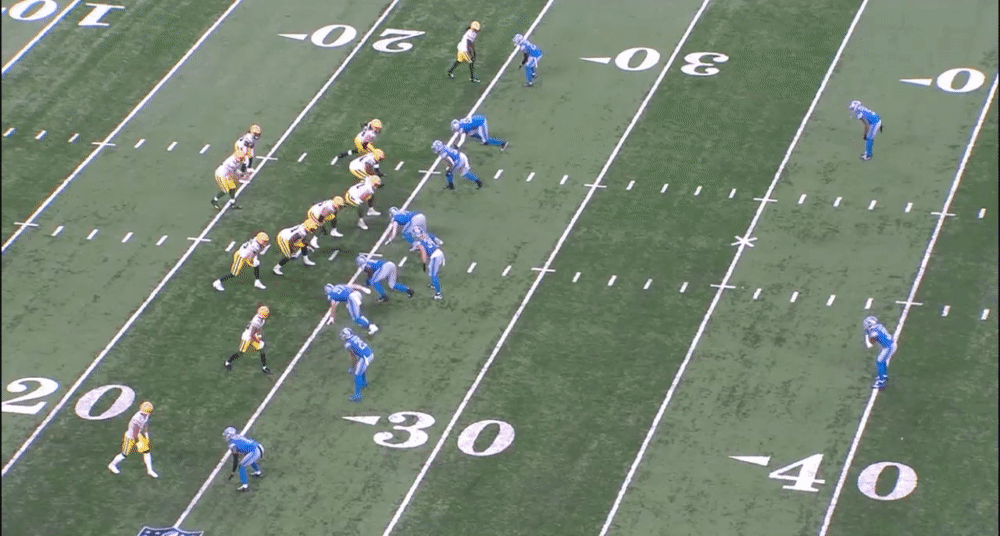
The Lions were able to get the Packers in third down twice more during the possession, but third-and-one both times. Running back AJ Dillon powered forward for the first, despite Elliott crashing off the edge and making a good stop.
With the second, Rodgers rolled out of the pocket and put Barnes in conflict between staying in his zone coverage responsibility or coming forward to defend a potential scramble. Caught in no-man’s land, the quarterback floated it over the linebacker’s head to his tight end Marcedes Lewis for a 19-yard gain down to the 5.

But oftentimes it’s better to be lucky than good. On first-and-goal, Rodgers tried to fire a slant to receiver Allen Lazard in the end zone, but didn’t see Barnes in the passing lane. The linebacker didn’t even have enough time to react, with the quick, low throw hitting him in the helmet. The ball deflected high into the air where safety Kerby Joseph was able to go up and snag the interception.
Second series: Seven plays, 57 yards, interception
Again, the Lions managed to get the Packers in a bad spot early in the possession following a holding penalty. But on third-and-10, Rodgers took a one-on-one deep shot to Lazard, covered by Jeff Okudah, and the receiver was able to outmuscle the cornerback in tight coverage, maintain his balance and get down to the 1-yard line.
But in the most impressive stretch of the contest, the Lions held the Packers out of the end zone four straight plays. On the first snap, a handoff to Dillion, the Lions clogged the inside lanes, while Joseph and Barnes held the edge, combining to make the no-gain stop when the back bounced his run outside.
Rodgers’ attempted a back-shoulder fade to Sammy Watkins on second down, but despite Hughes playing with inside leverage pre-snap, the receiver was not on the same page as his quarterback, attempting to run a slant as the ball sailed harmlessly out of the reach of any player.
Detroit’s run defense held firm again on third down with defensive tackle Benito Jones standing up right guard Zach Tom and Barnes crashing hard into his interior gap assignment to make an authoritative stop on Dillion.
The Packers turned to some trickeration on fourth down, declaring left tackle David Bakhtiari eligible, lining him up at tight end and having him run a delayed route into the flat on the backside of the play.
Obviously, Hutchinson gets a lot of credit for recognizing something was off when Bakhtiari intentionally released his block, causing the defender to drift back into coverage. But the unsung hero on the play is Buggs, who immediately split two blockers on the snap and was in Rodgers face as the QB turned around, forcing the underthrow that allowed Hutchinson to be in position to make the interception.
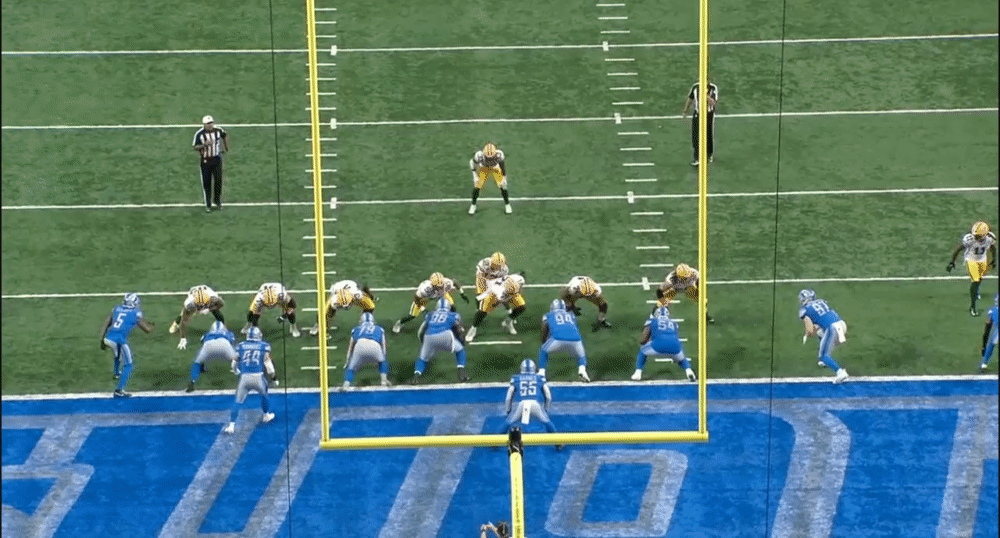
Third series: 12 plays, 61 yards, turnover on downs
Likely building off the goal line stop the previous possession, you could sense the Lions’ swagger starting to grow here.
It didn’t hurt that Jacobs entered the game and looked like a hungry dog let off his leash, breaking up a sideline shot on his first snap and crashing down to make a run stop on the second. But the Packers continued to have third-down success, with rookie Christian Watson taking a short throw and narrowly escaping Will Harris’ tackle attempt near the sideline. Shortly after, when facing third-and-7, Lazard took advantage of soft man coverage by Okudah to haul in a short hitch for 8 yards and the conversion.
Two plays later, the Lions recorded their only sack of Rodgers. A good coverage disguise, with the safety rolling down and Harris dropping deep as a Cover-2 replacement caused the QB to hesitate, while pressure from Hutchinson’s bull rush and Barnes on the blitz forced Rodgers to pull the ball down. The QB desperately tried to escape the pocket, but the linebacker was able to get home for his first sack of the season.
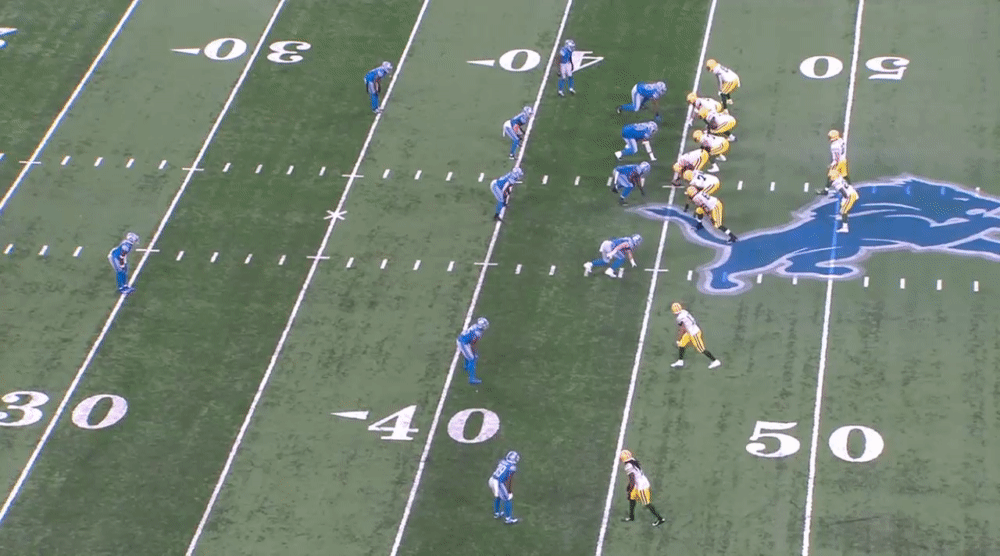
The Packers managed to get back 15 on third-and-18 with a smartly designed slot screen to Jones, putting them in position to go for it on fourth down. The Lions reverted to man coverage, and Rodgers tried another 50/50 throw to Lazard, working against Harris in the slot. Both the pass and coverage were excellent, but by getting his arm in between the receiver and the ball, the cornerback was able to get enough disruption to cause an incompletion.
Fourth series: One play, -1 yard, end of half
Taking over with 15 seconds remaining in the second quarter, the Packers took a knee. Nothing to see here.
Fifth series: Six plays, 23 yards, punt
Coming out of the break, a three-and-out continued to elude the Lions as the Packers converted yet another third down. In this instance, it was simply a case of Harris losing one-on-one as Watson beat him cleanly on an in-breaking route from the slot for an 18-yard gain.
But that was all for the Packers this drive. Harris and Jacobs both made quick reads on a pitch to Jones, dropping the back for a 6-yard loss on first down. And on third-and-11, the Lions again disguised their coverage, putting both safeties at the line of scrimmage and having the sprint back into deep zones at the snap. Rodgers tested the look with a deep shot down the middle to receiver Samori Toure, but the long and rangy Joseph was in position to make a leaping breakup just short of the goal line, forcing a punt.
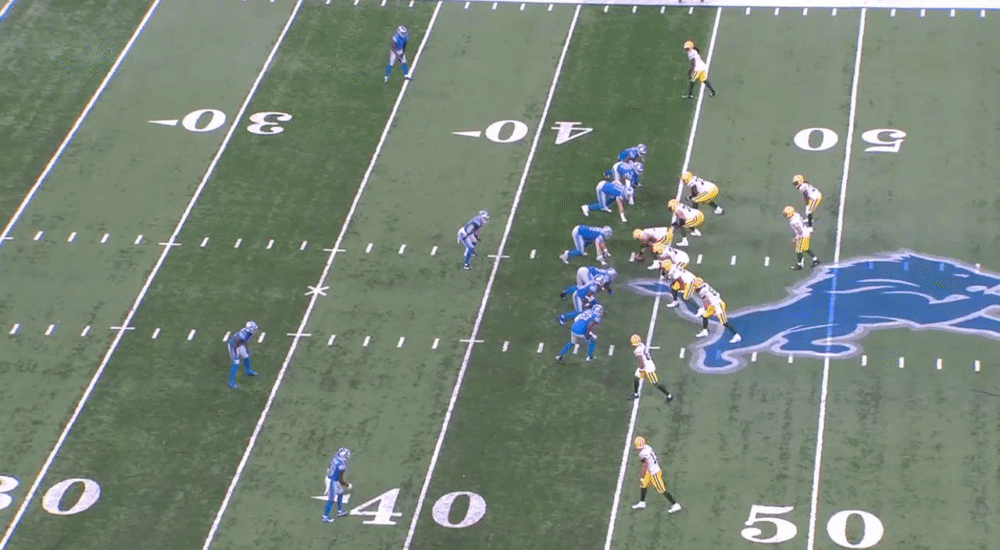
Sixth series: Two plays, one yard, interception
Following a Jared Goff interception, the defense was put in a tough spot to preserve a shutout, but Joseph came through once again. After an effective run stop that saw Hutchinson power through a cut block attempt to assist Elliott to drop Dillon after one yard, Rodgers looked to the end zone, targeting tight end Robert Tonyan in the middle of the field.
The Lions show a Cover-2 prior to the snap, but it’s more of a Cover-1 to counter Green Bay’s five receiving options. Barnes tracks Tonyan’s vertical route through the underneath zone before passing him off to Joseph. Rodgers releases the ball shortly after his tight end breaks in on a skinny post, but because the ball has a low trajectory, the rookie safety is able to undercut the throw and come down with his second interception of the game.
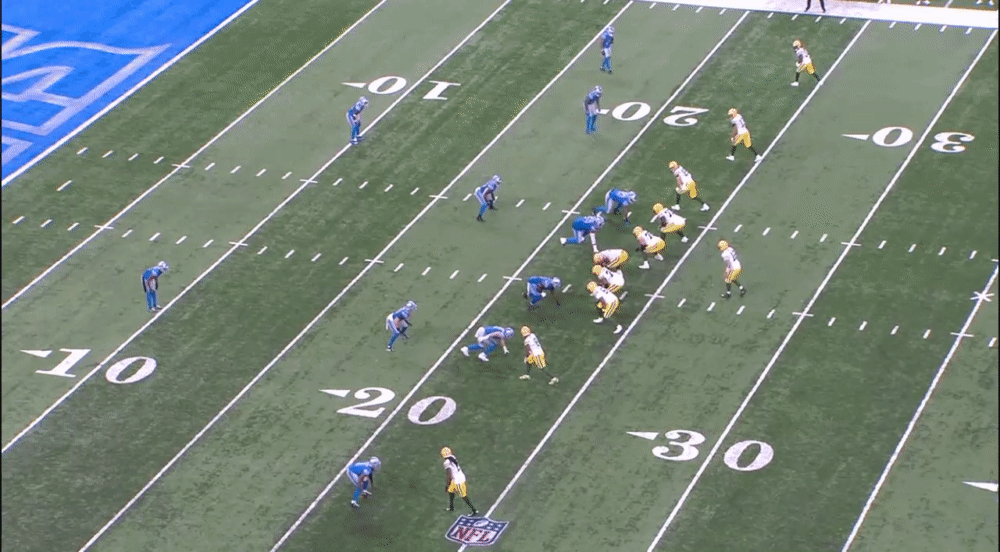
Seventh series: Seven players, 49 yards, touchdown
After another short offensive series gave the Packers a short field, the Lions defense finally conceded some points. After crossing midfield on a zone beating comeback route, the Packers found themselves in another third-and-long, needing 8 yards to keep the drive alive.
The Lions dropped eight on the snap with a Tampa-2 defensive look and had Rodgers’ options covered well, forcing the QB to scramble, where he was dropped just short after a 7-yard gain. But a flag on the play revealed Harris’ hands got up too high when jamming Lazard, making contact with the receiver’s face and drawing an automatic first down.
Two plays later, Rodgers connected with Lazard on a corner pattern, beating the man-to-man coverage of Okudah. The cornerback was tight throughout the route, but the throw was just wide enough to prevent the defender from making a play on the ball.
To his credit, Okudah got a measure of revenge on the two-point try, blanketing Lazard and forcing an incompletion on the unsuccessful attempt.
Eighth series: 14 plays, 71 yards, field goal
After an offensive hold against the Packers, the Lions should have been able to escape unscathed from a third-and-17 situation, but Rodgers was able to scramble for another first down. This time, the defense was in better position to make a stop, but both Anzalone and Barnes overcommitted on a late pump fake, while Elliott was late to react from his deep zone, resulting in the QB gaining 18.
Green Bay found some rare success on the ground after that Rodgers’ conversion, with Dillon and Kylin Hill each running for a first down with a second-down carry, but a second offensive pass interference put the Packers behind the sticks again.
Unfortunately for the Lions, Jacobs gave it right back with a defensive pass interference, grabbing the jersey of Toure as he ran a go route from the left slot. That set the Packers up with a fresh set of downs in the red zone, where on third-and-3, Jacobs bounced back by tightly defending a slant pass intended for Watkins, forcing Green Bay to settle for a field goal.
Ninth series: Eight plays, 40 yards, turnover on downs
The Lions got an early third-down stop when linebacker Chris Board shot into the flat and stopped Dillon short of the marker by forcing a fumble that trickled out of bounds. But with under two minutes to go, it was four-down territory and Rodgers went back to the 50/50 well, throwing a deep shot to Toure, working against Okudah.
The coverage was tight on the deep crossing pattern, but the cornerback lost his positioning when he turned to locate the ball. Okudah recovered to force a fumble, but again, the ball ended up out of bounds before the Lions could secure possession.
That set up the Packers inside the red zone, but they wouldn’t gain another yards. Tight man coverage forced Rodgers to throw it away on first down, while Jacobs punished Lazard with physicality on second down, which might have resulted in a penalty if Rodgers’ throw was deemed catchable.
Backup safety C.J. Moore came up with a tremendous pass breakup as the middle man in Cover-3 on a post to Watkins on third down.
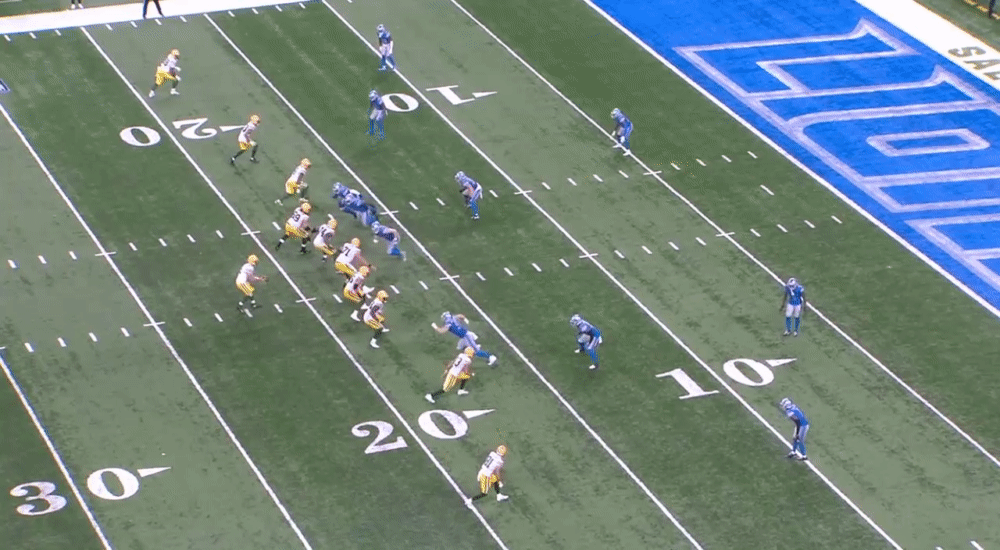
Finallly, on fourth, Jacobs bullied the same receiver, again fortunate to avoid a penalty as Rodgers and Watkins pleaded for a flag as the Lions took over on downs, took a knee and capped the victory.
Concluding thoughts
Obviously a great day for Detroit’s defense, but one heavily aided by turnovers. At this point, that’s not something that can be viewed as repeatable, given the sample size, although Joseph’s playmaking ability is becoming more and more apparent.
In addition to Joseph’s rapid ascension, Jacobs clearly is Detroit’s best option on the outside opposite Okudah. Rotating in Hughes while Jacobs works fully into football shape isn’t too detrimental. Hughes is playing more reliably than Amani Oruwariye has at any point this season. In the slot, Harris was an improvement, but he still had some coverage lapses that future opponents will likely look to exploit.
Barnes’ play was a revelation. Tough to say it’s sustainable, but he stepped up in a big way and has been looking impressive coming forward in run support for a few weeks now.
Finally, Detroit continues to need more from reliability from its pass rush. Buggs was obviously key on Hutchinson’s pick, and there was considerably more overall pressure on Rodgers than initially perceived, but the lack of sacks confirms the Lions are still struggling to finish. With Justin Fields on deck, pressure matters, because he’s not as good of a decision-maker as Rodgers when moved off his spot, but if you can’t shut down the run lanes, he’ll kill you with his feet.
jdrogers@detroitnews.com
Twitter: @Justin_Rogers